Uncategorized
The historian who uncovered the ADL’s secret plot against the far-right John Birch Society
(JTA) — A historian leafing through files in an archive discovered how a Jewish organization helped bring down an influential far-right extremist movement in the United States in the 1960s and ’70s by going undercover and acting as self-appointed spies.
The discovery of the Anti-Defamation League’s covert operation targeting the John Birch Society is the basis of a chapter in a new book by political historian Matthew Dallek of George Washington University. Published in March, “Birchers: How the John Birch Society Radicalized the American Right” is Dallek’s fourth book. It examines the roots of today’s emboldened conservative movement in the United States.
“Birchers” is a history of a group that at its height numbered as many as 100,000 members and “mobilized a loyal army of activists” in a campaign against what it saw as a vast communist conspiracy. He also examines how the Birchers’ mission to defend Christianity and capitalism morphed into a radical anti-civil rights agenda that groups like the ADL saw as an existential threat.
Dallek, who grew up in a Reform Jewish household in Los Angeles, recently sat with the Jewish Telegraphic Agency to discuss the rise of the Birchers, how the ADL infiltrated their ranks and whether such tactics are justified in the name of fighting extremism.
The conversation has been edited for clarity and brevity.
JTA: Before we get into the Jewish aspect of the book, meaning the chapter on the Anti-Defamation League’s relationship with the John Birch Society, let’s take a step back. Who are so-called Birchers? Why do they matter?
Mathew Dallek: The John Birch Society was a household name in the 1960s, becoming the emblem of far-right extremism. It didn’t have huge numbers, but it did penetrate the culture and the national consciousness. Its leader, Robert Welch, had argued at one point that President Dwight Eisenhower was a dedicated agent of a communist conspiracy taking over the United States. Welch formed the John Birch Society to educate the American people about the nature of the communist threat.
In its heyday, the group had about 60,000 to 100,000 members, organized into small chapters. They sent out literature trying to give members roadmaps or ideas for what they could do. They believed a mass education of the public was needed because traditional two-party politics was not going to be very effective at exposing the communist threat. They would form front groups such as Impeach Earl Warren [the Supreme Court’s chief justice] or Support Your Local Police. They tried to ban certain books that they viewed as socialistic from being used in schools. Some Birchers ran for school board seats and protested at libraries.
Critics feared that the Birchers were a growing fascist or authoritarian group and that if they were not sidelined politically and culturally then the country could be overrun. The Nation magazine wrote that Birchers essentially had given their followers an invitation to engage in civil war, guerrilla-style. Those fears sparked a big debate about democracy. How does one sustain democracy and, at the height of the Cold War and in the shadow of World War II, Nazi fascist Germany, and the Holocaust?
As you were researching, you came across a trove of historical internal documents from the ADL in the archives of the American Jewish Historical Society in New York. Why did you devote a chapter to what you found in those documents? What did those files reveal to you about the John Birch Society?
These papers are a goldmine. They’re this incredible and often detailed window into the far-right and, in particular, the John Birch Society. They show the ADL had an extensive, multi-dimensional counterintelligence operation that they were running against the Birch Society.
People knew at the time that the ADL was attending events where Birchers were speaking. But the ADL also had undercover agents with code names, who were able to infiltrate the society’s headquarters in Belmont, Massachusetts, and various chapter officers. They dug up financial and employment information about individual Birchers. And they not only used the material for their own newsletters and press releases, but they also fed information to the media.
Another layer is about a debate that’s been going on: Were the Birchers racist and antisemitic? The Birch Society always insisted that they did not tolerate white supremacy and didn’t want any KKK members. They said they accepted people of all faiths and races. And it’s true that they did have a handful of Jewish and Black members.
But what the ADL found was that a lot of hate was bubbling up from the grassroots and also leaking out from the top. The ADL was able to document this in a systematic way.
Some critics of the ADL today say the organization has strayed from its mission by focusing not just on antisemitism but on a wider array of causes. But from reading your work, it sounds like the ADL even then took an expansive view of its role, examining not just direct attacks on Jews but also how the political environment can jeopardize Jews. Am I getting that right, and why did the ADL devote so many resources to a group like the John Birch Society?
So, a few things: It’s the late ’50s and ’60s, and a civil rights coalition is emerging. Benjamin Epstein, the national director of the ADL, was friendly with Thurgood Marshall, the Supreme Court justice, and Martin Luther King. John F. Kennedy went to an ADL event and praised the ADL for speaking out very strongly in defense of democracy and pushing for the equal treatment of all Americans.
Isadore Zack, who helped lead the spy operation, at one point wrote to his colleagues that it was only in a democracy that the Jewish community has been allowed to flourish and so, if you want to defend Jewish Americans, you also have to defend democracy.
There certainly were other threats at the time, but the Birch Society was seen by liberal critics, including the ADL, as a very secretive group that promoted conspiracy theories about communists who often became conflated with Jews.
Would you consider the ADL successful in its campaign against the Birchers?
They were successful. They used surreptitious and in some cases underhanded means to expose the antisemitism and the racism and also interest in violence or the violent rhetoric of the Birch Society in the 1960s.
The ADL was at the tip of the spear of a liberal coalition that included the White House, sometimes the Department of Justice, depending on the issue, the NAACP, Americans for Democratic Action, labor unions, the union-backed Group Research Inc., which was tracking the far-right as well. The ADL was one of the most, if not the most effective at constraining and discrediting the society.
Clearly, however, the Birchers’ ideas never died. They lived on and made a comeback.
It’s somewhat ironic that you reveal the existence of this spying apparatus devoted to targeting an extremist and antisemitic group in the 1960s given the infamy the ADL would earn in a later era, the 1990s, for allegations that they colluded with police agencies in San Francisco to spy on and harass political activists. They eventually settled with the Arab American, Black and American Indian groups that brought a federal civil suit. I know you didn’t study these revelations, which are outside the scope of your book, but could you perhaps reflect on why undercover tactics were seen as necessary or justified?
It’s important to remember that in the mid-20th century, law enforcement in the United States was often led by antisemites or people who were much more concerned with alleged internal communist threats — the threat from the left.
From the ADL’s vantage point, one could not rely on the government entities that were by law and by design supposed to protect Jewish Americans. There was a sense that this work had to be done, at least in part, outside of the parameters of the government.
When I first discovered the ADL’s spying, I didn’t quite know what to make of it. But I realized they weren’t just spying to spy, they exposed a lot of scary things, with echoes in our own times — like easy access to firearms, a hatred of the government, a denigration and defamation of minority groups. And this was all happening in the shadow of the Holocaust and World War II. I became much more sympathetic; they were very effective, and they had a vision of equality of treatment for all Americans.
It’s obviously controversial. I try not to shy away from it. But they had a lot of good reasons to fight back right and to fight back in this nonviolent way.
That last thought brings to mind another, right-wing Jewish group that existed in this era of taking things into our own hands, that did use violence, explosives even.
You mean the Jewish Defense League, led by Meir Kahane.
Yes, exactly.
He was a Bircher. Toward the end of my book, I mention that he was a member for a while, under his alias Michael King.
Antisemitism is on the rise, and lots of initiatives are being organized to address it, both by existing groups like the ADL and new ones. The ADL’s budget has almost doubled over the past seven years. I am seeing Jews talk of fighting back and taking things into their own hands. And we are in this politically precarious movement in American history, all of which suggests parallels to the era you examined. What kind of wisdom can we glean from examining the ADL’s secret and public fight against the John Birch Society as people who care about the issues affecting Jews today?
A lot of liberals in the 1960s and a lot of the leadership at the ADL grasped the axiom that things can always get worse.
In 2015-2016, you’ll recall, there was Trump’s demonization of Mexican immigrants, and the so-called “alt-right” around him and his campaign and expressions of vitriol by people like Steve Bannon.
There was an assumption among a lot of Americans and among a lot of Jewish Americans that the fringe right — the antisemites, the explicit racists, the white supremacists — that there’s not a majority for them and they can never achieve power.
If you go back and you look at Trump’s closing 2016 campaign ad, it’s textbook antisemitism. He flashes on screen these wealthy Jewish international bankers, and he argues that basically, there’s a conspiracy of these global elites who are stealing the wealth of honest Americans. There’s also 2017, the white supremacists in Charlottesville, who said “Jews will not replace us” and Trump saying there are fine people on both sides.
The sense that democracy is incredibly fragile is not just a theory or a concept: It’s an actuality, the sense as well, that the United States has only been a multiracial democracy for not very long and a haven for Jews for not that long either.
The work that the ADL and the NAACP and other groups did to try to constrain and discredit as fringe and extremist still goes on today. It’s harder to do for all sorts of reasons today including social media and the loss of faith in institutions. But it still goes on. You see the importance of institutional guardrails including the Department of Justice that is prosecuting 1,000 Jan. 6 insurrectionists.
The last thing I’ll say is that one of the admirable things in the 1960s about the ADL and the liberal coalition it belonged to is that it built support for landmark legislation like the Immigration Act of 1965, the Civil Rights Act of 1964, and the Voting Rights Act of ’65. And a coalition eventually fell apart, but it was powerful, reminding us why Jewish American groups should care about or focus on issues that don’t directly affect Jewish people.
—
The post The historian who uncovered the ADL’s secret plot against the far-right John Birch Society appeared first on Jewish Telegraphic Agency.
Uncategorized
How the Global Religious Landscape Changed from 2010 to 2020

Muslims grew fastest; Christians lagged behind global population increase
• Christians are the world’s largest religious group, at 28.8% of the global population. They are a majority everywhere except the Asia-Pacific and Middle East-North Africa regions. Sub-Saharan Africa has surpassed Europe in having the largest number of Christians. But Christians are shrinking as a share of the global population, as millions of Christians “switch” out of religion to become religiously unaffiliated.
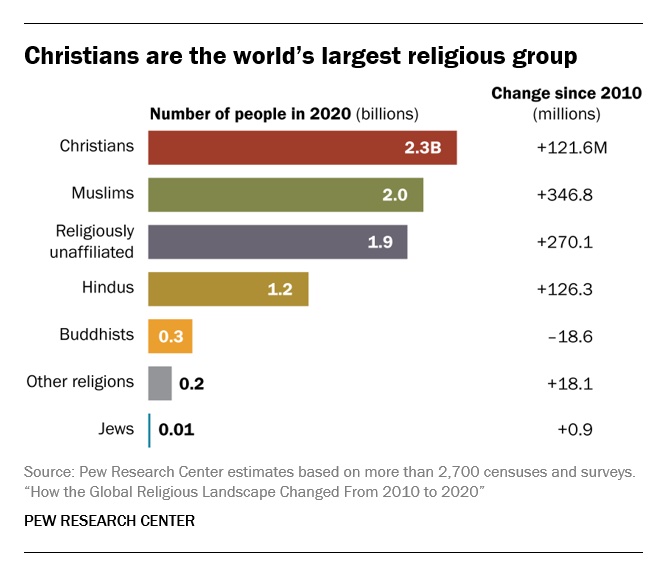
• Muslims are the world’s second-largest religious group (25.6% of the world’s population) and the fastest-growing major religion, largely due to Muslims’ relatively young age structure and high fertility rate. They make up the vast majority of the population in the Middle East-North Africa region. In all other regions, Muslims are a religious minority, including in the Asia-Pacific region (which is home to the greatest number of Muslims).
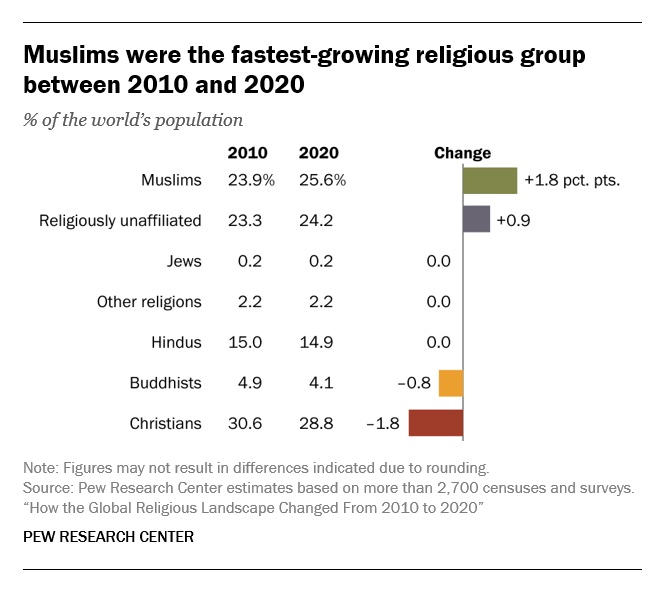
• The religiously unaffiliated population is the world’s third-largest religious category (24.2% of the global population), after Christians and Muslims. Between 2010 and 2020, religiously unaffiliated people grew more than any group except Muslims, despite their demographic disadvantages of an older age structure and relatively low fertility. The unaffiliated made up a majority of the population in 10 countries and territories in 2020, up from seven a decade earlier.
• Hindus are the fourth-largest religious category (14.9% of the world’s population), after Christians, Muslims and religiously unaffiliated people. Most (99%) live in the Asia-Pacific region; 95% of all Hindus live in India alone. Between 2010 and 2020, Hindus remained a stable share of the world’s population because their fertility resembles the global average, and surveys indicate that switching out of or into Hinduism is rare.
• Buddhists (4.1% of the world’s population) are the only group in this report whose number declined worldwide between 2010 and 2020. This was due both to religious disaffiliation among Buddhists in East Asia and to a relatively low birth rate among Buddhists, who tend to live in countries with older populations. Most of the world’s Buddhists (98%) reside in the Asia-Pacific region, the birthplace of Buddhism.
• Jews, the smallest religious group analyzed separately in this report (0.2% of the world’s population), lagged behind global population growth between 2010 and 2020 – despite having fertility rates on par with the global average – due to their older age structure. Most Jews live either in North America (primarily in the United States) or in the Middle East-North Africa region (almost exclusively in Israel).
These are among the key findings of a Pew Research Center analysis of more than 2,700 censuses and surveys, including census data releases that were delayed due to the coronavirus pandemic. This report is part of the Pew-Templeton Global Religious Futures project, which analyzes global religious change and its impact on societies around the world. Funding for the Global Religious Futures project comes from The Pew Charitable Trusts and the John Templeton Foundation.
Uncategorized
Antisemitism in some unlikely places in America

By HENRY SREBRNIK Antisemitism flourishes in a place where few might expect to confront it – medical schools and among doctors. It affects Jews, I think, more emotionally than Judeophobia in other fields.
Medicine has long been a Jewish profession with a history going back centuries. We all know the jokes about “my son – now also my daughter – the doctor.” Physicians take the Hippocratic Oath to heal the sick, regardless of their ethnicity or religion. When we are ill doctors often become the people who save us from debilitating illness and even death. So this is all the more shocking.
Yes, in earlier periods there were medical schools with quotas and hospitals who refused or limited the number of Jews they allowed to be affiliated with them. It’s why we built Jewish hospitals and practices. And of course, we all shudder at the history of Nazi doctors and euthanasia in Germany and in the concentration camps of Europe. But all this – so we thought – was a thing of a dark past. Yet now it has made a comeback, along with many other horrors we assume might never reappear.
Since the Hamas attack on Israel on October 7, 2023, there has been a resurgence of antisemitism, also noticeable in the world of healthcare. This is not just a Canadian issue. Two articles on the Jewish website Tablet, published Nov. 21, 2023, and May 18, 2025, spoke to this problem in American medicine as well, referencing a study by Ian Kingsbury and Jay P. Greene of Do No Harm, a health care advocacy group, based on data amassed by the organization Stop Antisemitism. They identified a wave of open Jew-hatred by medical professionals, medical schools, and professional associations, often driven by foreign-trained doctors importing the Jew-hatred of their native countries, suggesting “that a field entrusted with healing is becoming a licensed purveyor of hatred.”
Activists from Doctors Against Genocide, American Palestinian Women’s Association, and CODEPINK held a demonstration calling for an immediate cease-fire in Gaza at the Hart Senate Office Building in Washington, D.C., Nov. 16, 2023, almost as soon as the war began. A doctor in Tampa took to social media to post a Palestinian flag with the caption “about time!!!” The medical director of a cancer centre in Dearborn, Michigan, posted on social media: “What a beautiful morning. What a beautiful day.” Even in New York, a physician commented on Instagram that “Zionist settlers” got “a taste of their own medicine.” A Boston-based dentist was filmed ripping down posters of Israeli victims and a professor at the University of Pennsylvania Perelman School of Medicine did the same. Almost three-quarters of American medical associations felt the need to speak out on the war in Ukraine but almost three-quarters had nothing to say about the war in Israel.
Antisemitism in academic medical centres is fostering noxious environments which deprive Jewish healthcare professionals of their civil right to work in spaces free from discrimination and hate, according to a study by the Data & Analytics Department of StandWithUs, an international, non-partisan education organization that supports Israel and fights antisemitism.
“Academia today is increasingly cultivating an environment which is hostile to Jews, as well as members of other religious and ethnic groups,” StandWithUs director of data and analytics, and study co-author, Alexandra Fishman, said on May 5 in a press release. “Academic institutions should be upholding the integrity of scholarship, prioritizing civil discourse, rather than allowing bias or personal agendas to guide academic culture.”
The study, “Antisemitism in American Healthcare: The Role of Workplace Environment,” included survey data showing that 62.8 per cent of Jewish healthcare professionals employed by campus-based medical centres reported experiencing antisemitism, a far higher rate than those working in private practice and community hospitals. Fueling the rise in hate, it added, were repeated failures of DEI (diversity, equity, and inclusion) initiatives to educate workers about antisemitism, increasing, the report said, the likelihood of antisemitic activity.
“When administrators and colleagues understand what antisemitism looks like, it clearly correlates with less antisemitism in the workplace,” co-author and Yeshiva University professor Dr. Charles Auerbach reported. “Recognition is a powerful tool — institutions that foster awareness create safer, more inclusive environments for everyone.”
Last December, the Data & Analytics Department also published a study which found that nearly 40 per cent of Jewish American health-care professionals have encountered antisemitism in the workplace, either as witnesses or victims. The study included a survey of 645 Jewish health workers, a substantial number of whom said they were subject to “social and professional isolation.” The problem left more than one quarter of the survey cohort, 26.4 per cent, “feeling unsafe or threatened.”
The official journal of the Alliance for Academic Internal Medicine concurs. According to “The Moral Imperative of Countering Antisemitism in US Medicine – A Way Forward,” by Hedy S. Wald and Steven Roth, published in the October 2024 issue of the American Journal of Medicine, increased antisemitism in the United States has created a hostile learning and practice environment in medical settings. This includes instances of antisemitic behaviour and the use of antisemitic symbols at medical school commencements.
Examples of its impact upon medicine include medical students’ social media postings claiming that Jews wield disproportionate power, antisemitic slogans at the University of California, Los Angeles (UCLA) David Geffen School of Medicine, antisemitic graffiti at the University of California, San Francisco (UCSF) Cancer Centre, Jewish medical students’ exposure to demonization of Israel diatribes and rationalizing terrorism; and faculty, including a professor of medicine at UCSF, posting antisemitic tropes and derogatory comments about Jewish health care professionals. Jewish medical students’ fears of retribution, should they speak out, have been reported. “Our recent unpublished survey of Jewish physicians and trainees demonstrated a twofold increase from 40% to 88% for those who experienced antisemitism prior to vs after October 7,” they stated.
In some schools, Jewish faculty are speaking out. In February, the Jewish Faculty Resilience Group at UCLA accused the institution in an open letter of “ignoring” antisemitism at the School of Medicine, charging that its indifference to the matter “continues to encourage more antisemitism.” It added that discrimination at the medical school has caused demonstrable harm to Jewish students and faculty. Student clubs, it said, are denied recognition for arbitrary reasons; Jewish faculty whose ethnic backgrounds were previously unknown are purged from the payrolls upon being identified as Jews; and anyone who refuses to participate in anti-Zionist events is “intimidated” and pressured.
Given these findings, many American physicians are worried not only as Jewish doctors and professionals, but for Jewish patients who are more than ever concerned with whom they’re meeting. Can we really conceive of a future where you’re not sure if “the doctor will hate you now?”
Henry Srebrnik is a professor of political science at the University of Prince Edward Island.
Uncategorized
The 2025 Toronto Walk (and talk ) for Israel
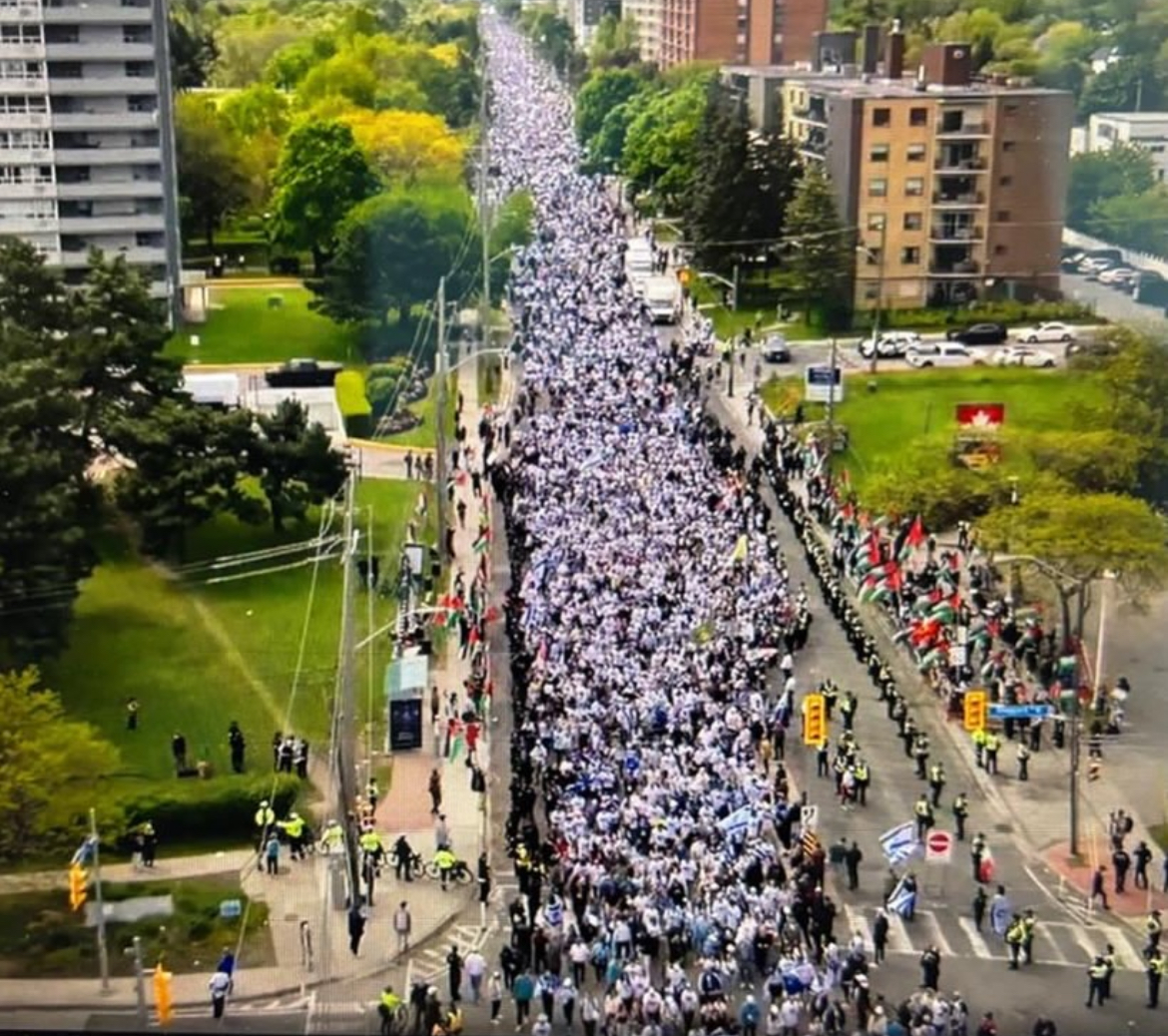
By GERRY POSNER There are walks and then there are walks. The Toronto UJA Walk for Israel on May 25, 2025 was one of a kind, at least as far as Canada and Jews are concerned. The number of people present was estimated to be 56,000 people or 112,000 total shoes. (How they get to that number is bewildering to me, since there is no one counting). This was 6,000 more than last year. Whether it is true or not, take it from me, it was packed. The synagogues in Canada should be so fortunate to get those numbers in total on High Holidays. The picture here gives you a sense of the size of the crowd.
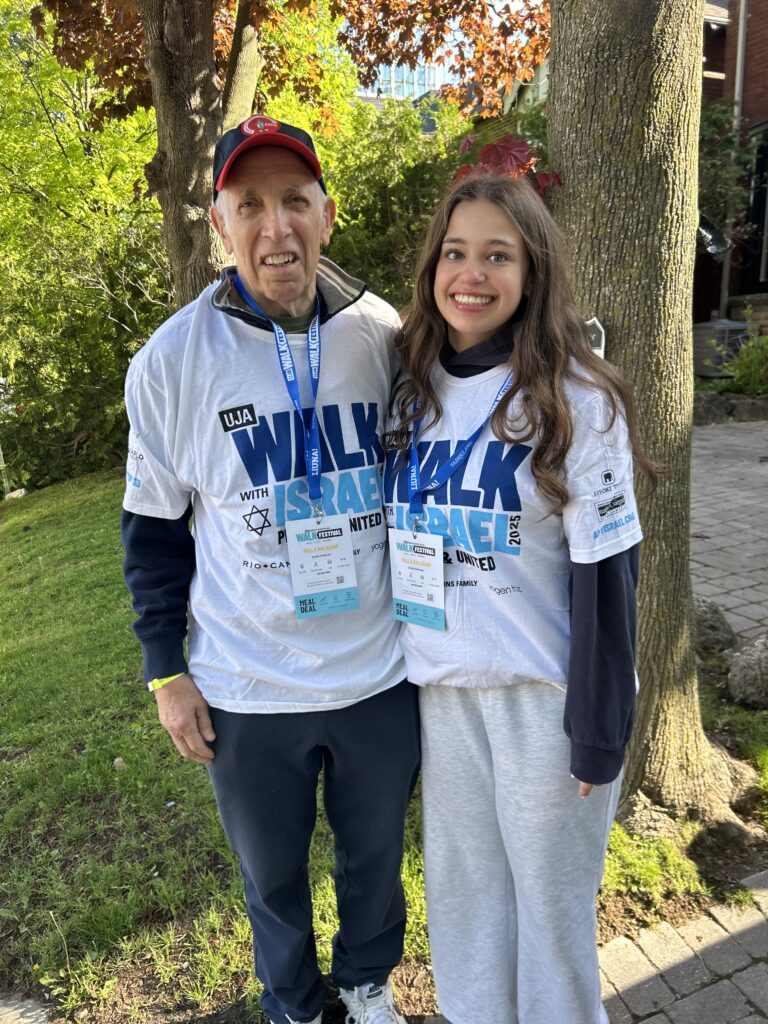
This was my first walk in Toronto for Israel and I was with my granddaughter, Samantha Pyzer (not to forget her two friends whom she managed to meet at the site, no small feat, even with iPhones as aids). The official proceedings began at 9:00 a.m. and the walk at 10:00 a.m. There was entertainment to begin with, also along the way, and at the finish as well. The finish line this year was the Prosserman Centre or the JCC as it often called. The walk itself was perhaps 4 kilometres – not very long, but the walking was slow, especially at the beginning. There were lots of strollers, even baby carriages, though I did not see any wheelchairs. All ages participated on this walk. I figured, based on what I could see on the faces of people all around me that, although I was not the oldest one on the walk, I bet I made the top 100 – more likely the top 20.
What was a highlight for me was the number of Winnipeggers I met, both past and present. Connecting with them seemed to be much like a fluke. No doubt, I missed la lot of them, but I saw, in no particular order (I could not recall the order if my life depended on it): Alta Sigesmund, (who was, a long time ago, my daughter Amira’s teacher), Marni Samphir, Karla Berbrayer and her husband Dr. Allan Kraut and family. Then, when Samantha and I made it to the end and sat down to eat, I struck up a conversation with a woman unknown to me and as we chatted, she confirmed her former Winnipeg status as a sister-in- law to David Devere, as in Betty Shwemer, the sister of Cecile Devere. I also chanced upon Terri Cherniack, only because I paused for a moment and she spotted me. As we closed in near the finish, I met ( hey were on their way back), Earl and Suzanne Golden and son Matthew, as well as Daniel Glazerman. That stop caused me to lose my granddaughter and her pals. Try finding them amid the noise and size of the crowd – but I pulled it off.
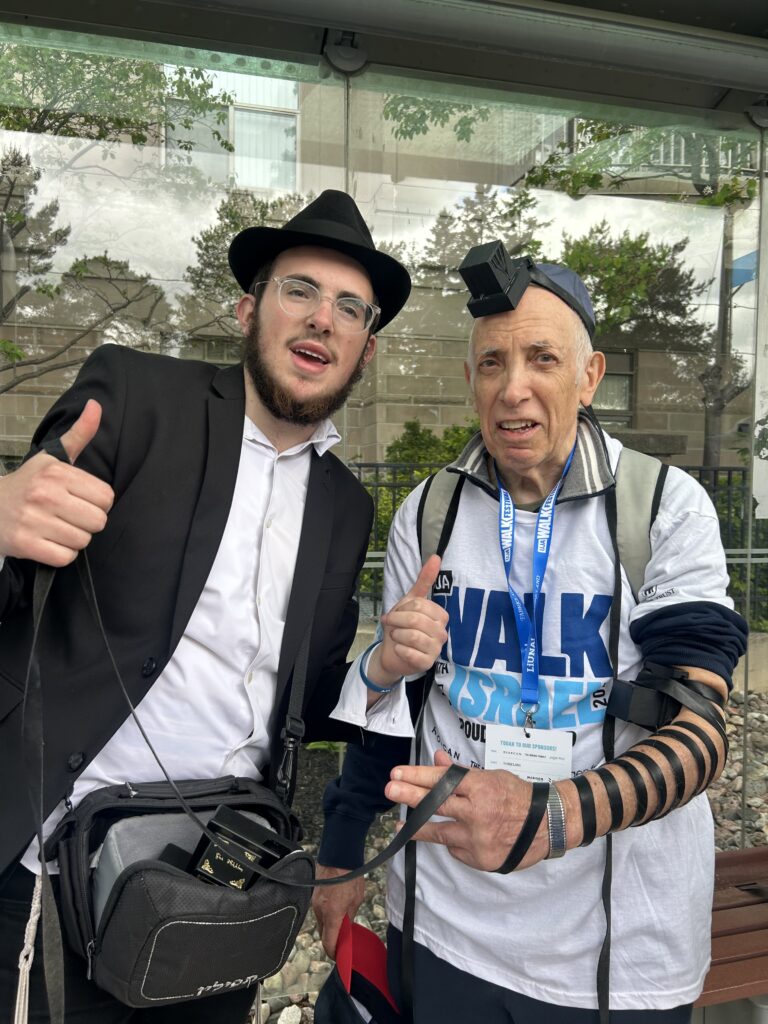
As I was in line to get food, I started chatting with a guy in the vicinity of my age. I dropped the Winnipeg link and the floodgates opened with “ Did I know Jack and Joanie Rusen?” So that was an interesting few minutes. And I was not too terribly surprised to come across some of my Pickleball family. All of these meetings, along with spotting some of my sister’s family and other cousins, were carried on with the sound of the shofar as we moved along the way. In short, this was a happening. Merchants selling a variety of products, many of them Israeli based, were in evidence and, of course, the day could not have ended without the laying of tefillin, aided by Chabad, who have perfected the procedure to take less than a minute. See the photo. Chabad had a willing audience.
Aside from the joy of sharing this experience with my granddaughter, the very presence of all these Jews gathered together for a common reason made this day very special to me. However, there was a downside to the day. The downside was that, as we began to walk back to our car there was no other way I could figure out how to return when the rains came and came. While we walked faster, we were impeded by pouring rain and puddles. But Samantha wanted to persevere, as did I. We made it, but were drenched. My runners are still drying out as I write this two days later.
What with being surrounded by 56,000 people, the noise, the slow walking, and the rain, I can still say the day was a real highlight for me – one of the better moments since our arrival in Toronto in 2012. As well as the photos we took along the way, I have the reminder of the day, courtesy of the UJA, as evidenced from the photo. It was not just the walk, but the talk that accompanied the walk that made it so worthwhile for me. I would do it again, minus the rain.
